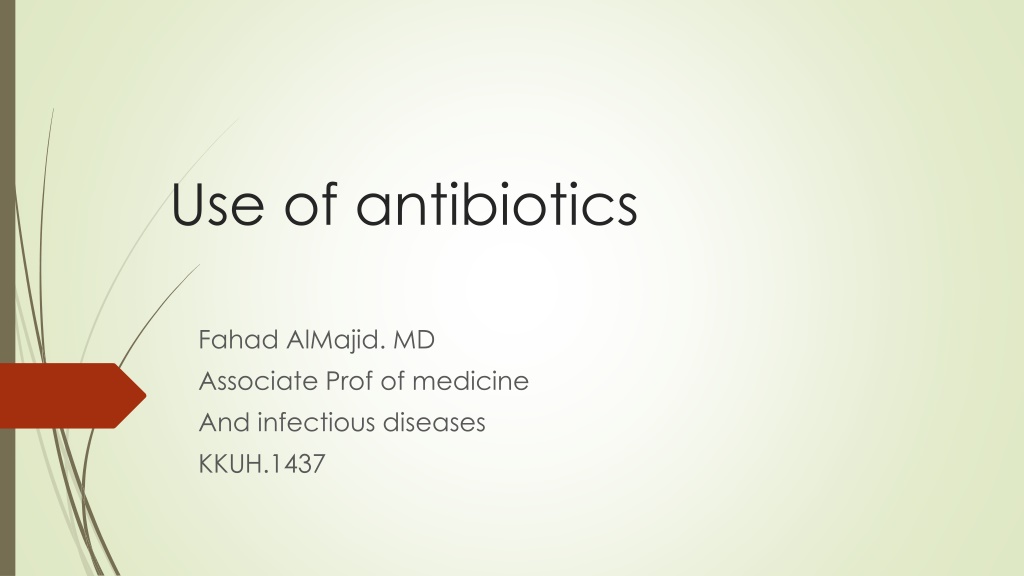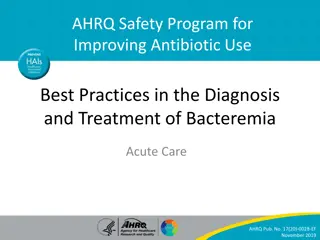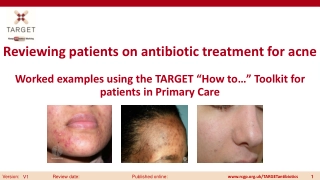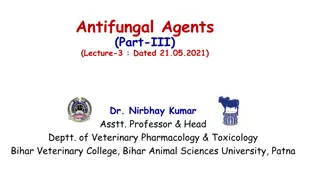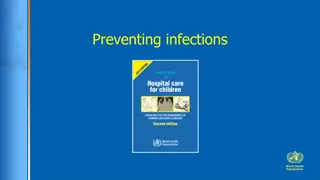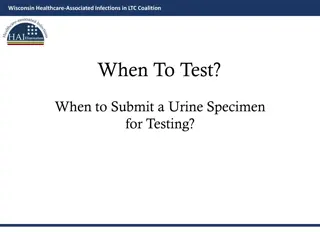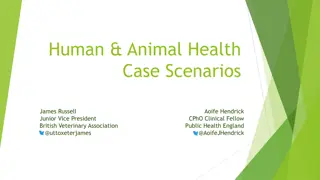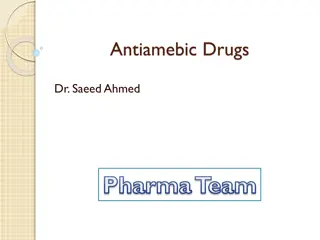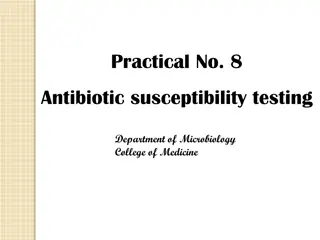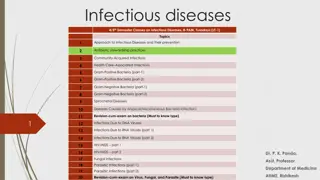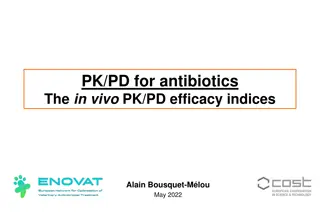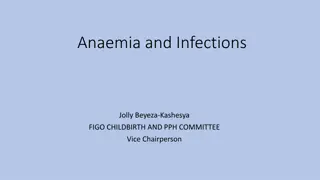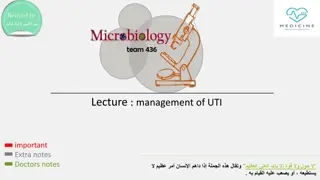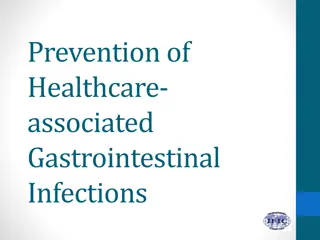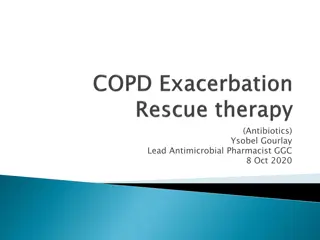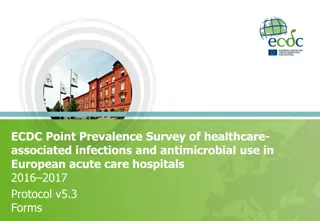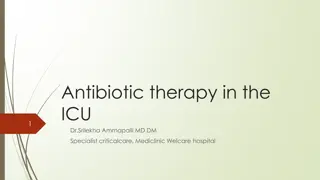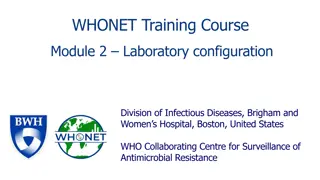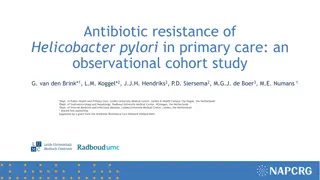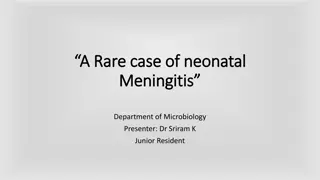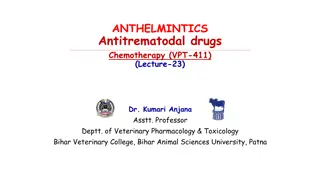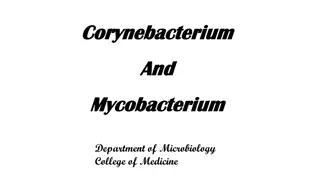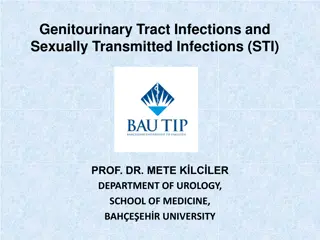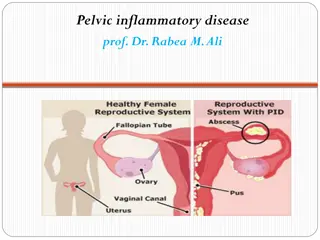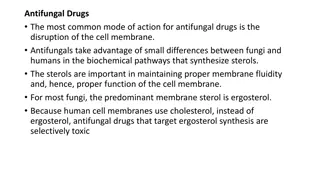Optimizing Antibiotic Use in Treating Infections
Antibiotics are vital for treating and preventing infections, but research shows they are often prescribed unnecessarily or misused. Evidence-based guidelines from IDSA can assist in choosing the right therapy based on accurate infectious disease diagnosis and microbiological understanding. Proper selection and initiation of antibiotic regimens, including obtaining diagnostic specimens before antimicrobial therapy, are crucial to effectively target pathogens and improve patient outcomes.
Download Presentation

Please find below an Image/Link to download the presentation.
The content on the website is provided AS IS for your information and personal use only. It may not be sold, licensed, or shared on other websites without obtaining consent from the author. Download presentation by click this link. If you encounter any issues during the download, it is possible that the publisher has removed the file from their server.
E N D
Presentation Transcript
Use of antibiotics Fahad AlMajid. MD Associate Prof of medicine And infectious diseases KKUH.1437
WHEN NEEDED to treat or prevent infection . They should always be used. But Research has shown: 50% of the time , antibiotics are prescribed either: 1. when not needed 2. Misused
Evidence-based practice guidelines from : the Infectious Diseases Society of America [ IDSA ] can help Direct appropriate therapy for specific infectious disease syndromes as well as for infections caused by specific microorganisms
SELECTING AND INITIATING AN ANTIBIOTIC REGIMEN Obtaining an Accurate Infectious Disease Diagnosis 1] Determining the site of infection, 2] Defining the host (e.g. immunocompromised, diabetic, of advanced age), 3] Establishing, when possible, a microbiological diagnosis
SELECTING AND INITIATING AN ANTIBIOTIC REGIMEN Obtaining an Accurate Infectious Disease Diagnosis Establishing, when possible, a microbiological diagnosis It is critical to isolate the specific pathogen in many serious, life-threatening infections, especially for situations that are likely to require prolonged therapy eg, : A] Endocarditis, B] Septic arthritis, C] Meningitis.
SELECTING AND INITIATING AN ANTIBIOTIC REGIMEN Obtaining an Accurate Infectious Disease Diagnosis To optimize an accurate microbiological diagnosis, Diagnostic specimens are properly obtained and promptly submitted to the microbiology lab, preferably before the institution of antimicrobial therapy
SELECTING AND INITIATING AN ANTIBIOTIC REGIMEN Obtaining an Accurate Infectious Disease Diagnosis The most likely microbiological aetiology can be inferred from the clinical presentation. For example, Cellulitis is most frequently assumed to be caused by streptococci or staphylococci, and antibacterial treatment can be administered in the absence of a positive culture.
SELECTING AND INITIATING AN ANTIBIOTIC REGIMEN Obtaining an Accurate Infectious Disease Diagnosis Community-acquired pneumonia that does not warrant hospitalization can also be treated empirically with antibiotics without performing specific diagnostic test.
SELECTING AND INITIATING AN ANTIBIOTIC REGIMEN Timing of Initiation of Antimicrobial Therapy Urgency of the situation. Antibiotics has to be given urgently to critically ill patients, such as those in 1] Septic shock 2] Febrile neutropenic patients, 3] bacterial meningitis, Empiric therapy should be initiated immediately after or concurrently with collection of diagnostic specimens.
SELECTING AND INITIATING AN ANTIBIOTIC REGIMEN Stable clinical situation : antimicrobial therapy should be deliberately withheld until : appropriate specimens have been collected and submitted to the microbiology laboratory. Important examples of this 1] subacute bacterial endocarditis and 2] vertebral osteomyelitis/diskitis.
SELECTING AND INITIATING AN ANTIBIOTIC REGIMEN Premature initiation of antimicrobial therapy in these circumstances can suppress bacterial growth and preclude the opportunity to establish a microbiological diagnosis, which is critical in the management of these patients, who require several weeks to months of directed antimicrobial therapy to achieve cure.
SELECTING AND INITIATING AN ANTIBIOTIC REGIMEN Empiric vs Definitive Antimicrobial Therapy Inadequate therapy in very sick patient is associated with poor outcomes, and Microbiological results do not become available for 24 to 72 hours.. This my results in : 1] greater morbidity and mortality 2] increased length of stay. Therefore, a common approach is: to use broad-spectrum antimicrobial agents as initial empiric therapy (sometimes with a combination)
SELECTING AND INITIATING AN ANTIBIOTIC REGIMEN Who combination? The intent IS to cover multiple possible pathogens commonly associated with the specific clinical syndrome ..e.g : healthy young adult with suspected bacterial meningitis: pathogens would be Streptococcus pneumoniae and Neisseria meningitidis, and thus a combination of a third-generation cephalosporin plus vancomycin
SELECTING AND INITIATING AN ANTIBIOTIC REGIMEN Hospital-acquired infections : are frequently related to the presence of invasive devices and procedures that result in loss of the normal barriers to infection A] intravascular catheter associated bacteremia, B] ventilator-associated pneumonia, and catheter-associated C] urinary tract infections (UTIs). commonly caused BY Drug-resistant organisms, both gram-positive (eg, methicillin- resistant Staphylococcus aureus [MRSA]) and gram negative (eg, Pseudomonas aeruginosa) bacteria, which are often endemic in hospitals.
SELECTING AND INITIATING AN ANTIBIOTIC REGIMEN Empiric vs Definitive Antimicrobial Therapy Selecting empiric antimicrobial Consider the following: (1) the site of infection and the organisms most likely to be colonizing that site (eg, intravascular catheter associated bacteremia is caused by staphylococci present on the skin. (2) prior knowledge of bacteria known to colonize nasal CAVITY [currently nasal swab is conducted routinely by many hospitals before admitting patients to the intensive care unit] may indicate that the patient is colonized with MRSA. (3) The local bacterial resistance patterns or antibiograms that are available for important pathogens at most hospitals.6
SELECTING AND INITIATING AN ANTIBIOTIC REGIMEN Empiric vs Definitive Antimicrobial Therapy Once the etiologic pathogen IS identified with antimicrobial susceptibility every attempt should be made to narrow the antibiotic spectrum. This is a critically important component of antibiotic therapy because it can 1] Reduce cost 2] Reduce toxicity 3] prevent the emergence of antimicrobial resistance in the community.
SELECTING AND INITIATING AN ANTIBIOTIC REGIMEN Interpretation of Antimicrobial Susceptibility Testing Results microorganism is identified in clinical cultures,..then antimicrobial susceptibility testing (AST). Antimicrobial susceptibility testing measures the ability of a specific organism to grow in the presence of a particular drug in vitro Data are reported in the form of Minimum inhibitory concentration (MIC): The lowest concentration of an antibiotic that inhibits visible growth of a microorganism: susceptible, resistant, or intermediate,
SELECTING AND INITIATING AN ANTIBIOTIC REGIMEN Interpretation of Antimicrobial Susceptibility Testing Results Susceptible : The isolate is likely to be inhibited by the usually achievable concentration of a particular antimicrobial agent when the recommended dosage is used for the particular site of infection. AST has some limitations that should be kept in mind.
SELECTING AND INITIATING AN ANTIBIOTIC REGIMEN Interpretation of Antimicrobial Susceptibility Testing Results 23 years old man who has surgery at the base of the skull After trauma . Presented few days later with meningitis CSF has revealed : WBC 1200 mail=nly poly Culture : staph aureus susceptible to cephazolin RX cephazolin Outcome:..Death..Why ?
SELECTING AND INITIATING AN ANTIBIOTIC REGIMEN Interpretation of Antimicrobial Susceptibility Testing Results Susceptible to cefazolin in vitro; But the isolate was obtained from the cerebrospinal fluid (CSF) SO what ? cefazolin would not be an optimal therapeutic choice because it does not achieve therapeutic concentrations in the CSF.
SELECTING AND INITIATING AN ANTIBIOTIC REGIMEN Use of Antimicrobial Combinations Although single-agent antimicrobial therapy is generally preferred, a combination of 2 or more antimicrobial agents is recommended in a few scenarios.: Synergistic Activity: the combined effect of the agents is greater than the sum of their independent activities when measured separately.
SELECTING AND INITIATING AN ANTIBIOTIC REGIMEN Use of Antimicrobial Combinations The combination of certain : b-lactams and aminoglycosides exhibits : Synergistic activity against a variety of gram-positive and gram-negative bacteria9 and is used in the treatment of serious Infections when : {1} Rapid killing is essential (eg,: treatment of endocarditis caused by Enterococcus species with Penicillin and gentamicin: bactericidal, whereas penicillin alone is only bacteriostatic and gentamicin alone has no significant activity. Result in more rapid clearance of the infecting microorganism
SELECTING AND INITIATING AN ANTIBIOTIC REGIMEN Use of Antimicrobial Combinations {2} shorten the course: Endocarditis due to viridians group streptococci: a combination of penicillin or ceftriaxone with gentamicin for 2 weeks can be as effective as penicillin or ceftriaxone alone for 4 weeks).
SELECTING AND INITIATING AN ANTIBIOTIC REGIMEN Use of Antimicrobial Combinations {3} critical ill patient : Empiric therapy for health care associated infections : Patient hospitalized for several weeks develops septic shock and blood cultures are reported to be growing : gram-negative bacilli, it would be appropriate to provide initial therapy with 2 agents that have activity against gram-negative bacilli, particularly P aeruginosa,
SELECTING AND INITIATING AN ANTIBIOTIC REGIMEN Use of Antimicrobial Combinations 4} Polymicrobial Infections: Antimicrobial combinations, such as a third-generation cephalosporin or a fluoroquinolone plus metronidazole, can be used as a potential treatment option in these cases and can sometimes be more cost-effective than a comparable single agent (eg, a carbapenem)
5} To Prevent Emergence of Resistance.: the chance of a mutant strain being resistant to both antimicrobial agents is much lower than the chance of it being resistant to either one. In other words, use of combination therapy would provide a better chance that at least one drug will be effective, thereby preventing the resistant mutant population from emerging as the dominant strain and causing therapeutic failure.
Host Factors to Be Considered in Selection of Antimicrobial Agents .? one size fits all ??? Renal and Hepatic Function. Because the kidney and the liver are the primary organs responsible for elimination of drugs from the body,..the dose reduction to prevent accumulation and toxicity in patients with reduced renal or hepatic function. Example: Pregnancy and Lactation. Special considerations for the use of antimicrobial agents in pregnancy relate to the fetus: many antimicrobial agents can be either teratogenic or otherwise toxic to the fetus.
Druge prohibited in pregnancy: as sulfonamides and nitrofurantoin .birth defect tetracyclines and chloramphenicol: well-described fetal or neonatal adverse effects History of Allergy or Intolerance. Pencillin and anaphylaxis History of Recent Antimicrobial Use. infection emerged under the selective pressure of a recently used antimicrobial agent, it is likely to be resistant to that drug and/or drug class, and an alternative agent should be used.
Oral vs Intravenous Therapy severity of their infection; candidates for treatment mild to moderate infections can be treated with well-absorbed oral antimicrobial agents (eg, treatment of pyelonephritis oral fluoroquinolones) and community-acquired pneumonia with Augmentin and macrolides coverage
bioavailability (ie, the percentage of the oral dose that is available unchanged in the serum). Examples of antibiotics with excellent bioavailability are fluoroquinolones, linezolid, trimethoprim-sulfamethoxazole, and metronidazole. Certain infection should not be treated orally: Meningitis,,
Efficacy at the Site of Infection In addition to in vitro antimicrobial activity and achieving adequate serum levels, : the efficacy of antimicrobial agents depends on their capacity to achieve a concentration equal to or greater than the MIC at the site of infection.
Antimicrobial concentrations attained at some sites (eg, ocular fluid, CSF, abscess cavity, prostate, and bone) are often much lower than serum levels For example, first- and second- generation cephalosporins and macrolides do not cross the blood-brain barrier and are not recommended for for nervous system infections
Fluoroquinolones achieve high concentrations in the prostate and are preferred oral agents for the treatment of prostatitis Daptomycin, an excellent bactericidal agent against gram-positive bacteria, is not useful for treatment of pneumonia (eg, pneumococcal pneumonia) because it is inactivated by lung surfactant. Vancomycin needs high concentration in the luns ineffective aminoglycosides) are less active in the low-oxygen, low-pH, and high-protein environment of Abscesses .. drainage of abscesses
moxifloxacin does not achieve significant urinary concentrations because of its low renal excretion and is therefore not suitable for treatment of UTIs.
Use of Therapeutic Drug Monitoring for medications that have a fairly narrow therapeutic index: This could be due primarily to toxicity at high levels (eg, aminoglycosides)21 or Therapeutic failure at low drug levels (eg, vancomycin) but is usually a combination of both (eg, voriconazole). In some cases, the use of serum drug level monitoring is supported by its beneficial effect on clinical outcomes (eg, voriconazole in the treatment of invasive fungal infections).24
Assessment of Response to Treatment Response to treatment: BY both clinical and microbiological parameters. Clinical parameters 1] Decrease in fever, tachycardia, or confusion), 2] laboratory values: (eg, decreasing leukocyte count), and 3] radiologic findings (eg, decrease in the size of an abscess). Although radiologic criteria are commonly used in assessing response to infectious disease therapy, radiologic improvement can frequently lag behind clinical improvement, and routine radiographic follow-up of all infections is not always necessary.
Bacteremia is the most common scenario in which microbiological response is closely assessed because clearance of the bloodstream is as important as clinical improvement. Persistent bacteremia can often be the only clue to the presence of an inadequately treated source or to the existence or development of endovascular infection (such as endocarditis or an intravascular device infection).
Adverse Effects Allergic or hypersensitivity reactions can be either immediate (IgE-mediated) or delayed and usually manifest as a rash; anaphylaxis is the most severe manifestation of IgE-mediated allergy ongoing reaction is attributed to an antimicrobial drug allergy, this usually requires discontinuation of the offending agent.
Antimicrobial Therapy for Foreign Bod y Associated Infections Emergence of infections associated with the placement of such devices, involving both Temporary : (eg, urinary catheter, central venous catheter) Permanent: (eg, prosthetic joint, artificial heart valve) implants. the important characteristics of devicerelated infection is the formation of biofilms: a structured community of bacterial cells enclosed in a self-produced polymeric matrix and adherent to an inert or living surface
prolonged antibiotic treatment for these infections can be ineffective, associated with adverse effects, and result in the emergence of resistant strains of organisms
However, because of the difficulty of eradicating infections with antimicrobial therapy alone, removal of the implant is often necessary for cure. As an alternative, for patients unable to tolerate implant removal, long-term suppressive antimicrobial therapy is sometimes used, with variable success.
Use of Antimicrobial Agents as Prophylactic or Suppressive Therapy Presurgical Antimicrobial Prophylaxis Antimicrobial prophylaxis is used to reduce the incidence of postoperative surgical site infections.. The antibiotic(s) should 1] cover the most likely organisms and be present in the tissues when the initial incision is made, and 2] adequate serum concentrations A single dose of a cephalosporin (such as cefazolin) administered within 1 hour before the initial incision is appropriate for most surgical procedures; this practice targets the most likely organisms (ie, skin flora), Duration should not exceed 24 hours in most cases.
Antimicrobial Prophylaxis to Prevent Transmission of Communicable Pathogens to Susceptible Contacts ciprofloxacin can be given to close contacts of a patient with meningitis caused by N meningitidis, Antimicrobial Prophylaxis Before Dental and Other Invasive Procedures: prosthetic valves, prior endocarditis, or congenital heart disease before surgical correction.43
JUDICIOUS USE OF ANTIMICROBIAL AGENTS Cost Considerations in Antibiotic Selection and Antimicrobial Stewardship: purchase price of a particular agent and may include administration costs, prolonged hospitalization as a consequence of adverse effects, the cost of serum concentration monitoring, One strategy that can significantly reduce cost is the switch from intravenous to oral therapy. Oral therapy is generally less expensive, potentially associated with fewer adverse effects, and can result in considerable cost savings by facilitating earlier dismissal and a shortened hospital Stay oral linezolid when compared with intravenous vancomycin for the treatment of complicated skin and soft tissue infections caused by MRSA.
Preventing Emergence of Antibiotic Resistance The widespread and often inappropriate use of antimicrobial agents is the single most important cause of the emergence of drug resistance, both in the community and hospital settings Clearly, the emergence of antimicrobial resistance can be prevented or delayed through judicious prescribing, which can be characterized as follows: avoidance of antibiotic treatment for community-acquired, mostly viral, upper respiratory tract infections; use of narrow-spectrum antibiotics when possible; and use of antibiotics for the shortest duration that is effective for the treatment of a particular clinical syndrome.
Common Misuses of Antibiotics rolonged Empiric Antimicrobial Treatment Without Clear Evidence of Infection: One of the most common mistakes in antimicrobial use is continuing to add or switch antibiotics when a patient does not appear to be responding to therapy, even though there is no clear evidence of an infectious disease Examples include adultonset Still disease and other connective tissue disorders that can present with high fever; drug-induced fever; the fever associated with pulmonary embolism; lymphoma ,Wegener granulomatosis, which can present with fever, cavitary pulmonary nodules, and recurrent sinusitis.
Treatment of a Positive Clinical Culture in the Absence of Disease: Colonization with potentially pathogenic organisms without any associated manifestation of disease occurs frequently in certain populations (eg, colonization of the urinary tract in women of advanced age or in the presence of an indwelling urinary catheter, colonization of endotracheal tubes in mechanically ventilated patients, and colonization of chronic wounds). avoiding treatment of a positive culture result when symptoms and signs of active infection are absent (eg, asymptomatic bacteriuria)
Prolonged Prophylactic Therapy. guidelines support the use of a single, preoperative dose of an antimicrobial agent. Prolonged prophylaxis simply sets the stage for the emergence of antimicrobial resistance.
Conclusion Appropriate use of antimicrobial agents involves obtaining an accurate diagnosis, determining the need for and timing of antimicrobial therapy, understanding how dosing affects the antimicrobial activities of different agents, tailoring treatment to host characteristics, using the narrowest spectrum and shortest duration of therapy, and switching to oral agents as soon as possible. In addition, nonantimicrobial interventions, such as abscess drainage, are equally or more important in some cases and should be pursued diligently in comprehensive infectious disease management.
